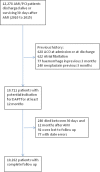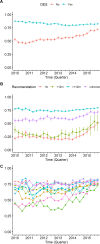Persistence with dual antiplatelet therapy after percutaneous coronary intervention for ST-segment elevation acute coronary syndrome: a population-based cohort study in Catalonia (Spain)
- PMID: 31340964
- PMCID: PMC6661631
- DOI: 10.1136/bmjopen-2018-028114
Persistence with dual antiplatelet therapy after percutaneous coronary intervention for ST-segment elevation acute coronary syndrome: a population-based cohort study in Catalonia (Spain)
Abstract
Objectives: Guidelines recommending 12-month dual antiplatelet therapy (DAPT) in patients with ST-elevation acute coronary syndrome (STEACS) undergoing percutaneous coronary intervention (PCI) were published in year 2012. We aimed to describe the influence of guideline implementation on the trend in 12-month persistence with DAPT between 2010 and 2015 and to evaluate its relationship with DAPT duration regimens recommended at discharge from PCI hospitals.
Design: Observational study based on region-wide registry data linked to pharmacy billing data for DAPT follow-up.
Setting: All PCI hospitals (10) belonging to the acute myocardial infarction (AMI) code network in Catalonia (Spain).
Participants: 10 711 STEACS patients undergoing PCI between 2010 and 2015 were followed up.
Primary and secondary outcome measures: Primary outcome was 12-month persistence with DAPT. Calendar year quarter, publication of guidelines, DAPT duration regimen recommended in the hospital discharge report, baseline patient characteristics and significant interactions were included in mixed-effects logistic regression based interrupted time-series models.
Results: The proportion of patients on-DAPT at 12 months increased from 58% (56-60) in 2010 to 73% (71-75) in 2015. The rate of 12-month persistence with DAPT significantly increased after the publication of clinical guidelines with a time lag of 1 year (OR=1.20; 95% CI 1.11 to 1.30). A higher risk profile, more extensive and complex coronary disease, use of drug-eluting stents (OR=1.90; 95% CI 1.50 to 2.40) and a 12-month DAPT regimen recommendation at discharge from the PCI hospital (OR=5.76; 95% CI 3.26 to 10.2) were associated with 12-month persistence.
Conclusion: Persistence with 12-month DAPT has increased since publication of clinical guidelines. Even though most patients were discharged on DAPT, only 73% with potential indication were on-DAPT 12 months after PCI. A guideline-based recommendation at PCI hospital discharge was highly associated with full persistence with DAPT. Establishing evidence-based, common prescribing criteria across hospitals in the AMI-network would favour adherence and reduce variability.
Keywords: ST-elevation myocardial infarction; dual antiplatelet therapy; percutaneous coronary intervention; persistence with treatment.
© Author(s) (or their employer(s)) 2019. Re-use permitted under CC BY-NC. No commercial re-use. See rights and permissions. Published by BMJ.
Conflict of interest statement
Competing interests: None declared.
Figures



References
-
- Steg PG, James SK, Atar D, et al. . ESC Guidelines for the management of acute myocardial infarction in patients presenting with ST-segment elevation: The Task Force on the management of ST-segment elevation acute myocardial infarction of the European Society of Cardiology (ESC). Eur Heart J 2012;33:2569–619. - PubMed
-
- O’Gara PT, Kushner FG, Ascheim DD, et al. . 2013 ACCF/AHA Guideline for the Management of ST-Elevation Myocardial Infarction: A Report of the American College of Cardiology Foundation/American Heart Association Task Force on Practice Guidelines. Circulation 2013;2013:e362–425. - PubMed
-
- Carrillo X, Fernandez-Nofrerias E, Rodriguez-Leor O, et al. . Early ST elevation myocardial infarction in non-capable percutaneous coronary intervention centres: in situ fibrinolysis vs. percutaneous coronary intervention transfer. Eur Heart J 2016;37:1034–40. 10.1093/eurheartj/ehv619 - DOI - PubMed
Publication types
MeSH terms
Substances
LinkOut - more resources
Full Text Sources
Medical
Miscellaneous
